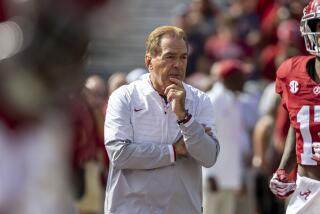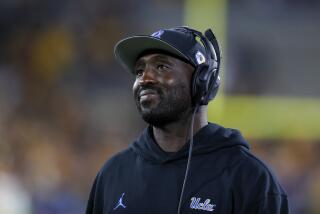NCAA rates major coaches by academic success of players
- Share via
The NCAA issued a controversial report Thursday that rates major college coaches by how well their athletes perform in the classroom.
These statistics, available to the public online, make use of the Academic Progress Rates that the NCAA has been compiling for Division I teams for the last six years.
The numbers are not new — they have been released annually on a team-by-team basis — but this is the first time they have been linked to specific coaches, even as some of those coaches moved from school to school.
The database shows that Nick Saban guided football teams to both winning records and academic success at Louisiana State and Alabama through 2009. It paints a less-flattering picture of Bob Huggins, whose basketball squads at Cincinnati and Kansas State struggled academically before he took over at West Virginia in 2006.
“We know that some coaches aren’t happy with this spotlight,” said Walter Harrison, chairman of the NCAA’s academic performance committee and University of Hartford president. “But I believe most of the coaches understand it and embrace it and know that it comes with the territory.”
Reaction from the coaching community has been mixed. Some welcome the scrutiny; others complain that the report could put them in a bad light for the study habits of teenagers, something they cannot always control.
Coaches who have switched schools worry that they will be judged on players they did not recruit.
The inaugural report was limited to the high-profile sports of football, baseball, men’s and women’s basketball and women’s indoor and outdoor track and field. Later in the year, the NCAA will publish data on coaches in all sports.
Officials said they hope the Head Coach APR Portfolio will be useful for high school recruits choosing among schools.
The APR rates teams by awarding points for each athlete who remains eligible and progresses toward graduation. Teams are expected to reach a benchmark of 925, which equates roughly to a 60% graduation rate.
Low scores can result in loss of scholarships and other penalties for teams, but no such action is planned for coaches.
“These rates are not meant to be punitive or single out coaches,” Harrison said.
Most local coaches had nothing to worry about.
For all the controversy surrounding Pete Carroll in the wake of NCAA sanctions leveled against USC, his teams consistently exceeded academic standards from 2003 through 2009. Lane Kiffin arrives from Tennessee with a 928 for 2008-09, a score he shared with previous Volunteers coach Phillip Fulmer.
At UCLA, basketball Coach Ben Howland and football Coach Rick Neuheisel scored well.
But the coaches’ APR underscored problems with the Cal State Northridge men’s basketball program, where Coach Bobby Braswell’s players have a history of underperforming in the classroom.
The NCAA recently reduced the team’s scholarships and practice hours as part of an APR-related penalty.
Thursday’s report also showed that USC basketball teams led by former coaches Henry Bibby and Tim Floyd fell below the 925 level during three of the last six school years.
Those numbers could be blamed, in part, on players jumping to the NBA and failing to complete their final semester in school.
NCAA interim President Jim Isch said the “vast majority” of coaches came away looking good and can brag about their APR score to recruits.
For those who cannot, officials hope the new data will lead to greater accountability.
“We believe the college sports culture is changing and changing for the better,” Harrison said. “We think the head coach APR is another way to reflect this emphasis on academics.”
david.wharton@latimes.com
twitter.com/LATimesWharton
More to Read
Go beyond the scoreboard
Get the latest on L.A.'s teams in the daily Sports Report newsletter.
You may occasionally receive promotional content from the Los Angeles Times.











